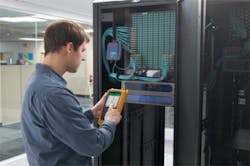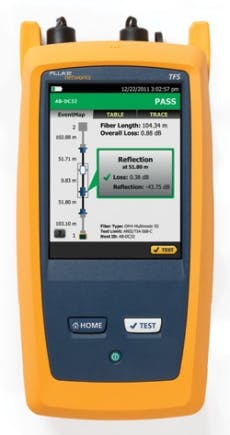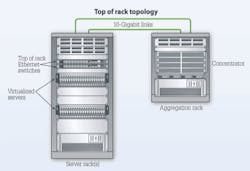From the May, 2012 Issue of Cabling Installation & Maintenance Magazine
The integrity of a data center’s infrastructure is inextricably linked to the strength of its fiber network.
By David Veneski, Fluke Networks
The demand for greater bandwidth in the enterprise is growing exponentially. It is driven by a variety of factors, including virtualization, the rise of the cloud, access to storage via Ethernet, server-to-server traffic, and ever-larger oceans of data that need to be accessed. As fiber becomes the core of every data center network, the need to certify and test it becomes equally critical.
When fiber represented a minority of an enterprise’s network links, either in the storage area network (SAN) or the wide area link to the Internet, the job of fiber test and management was typically outsourced to specialists. However, today when organizations rely heavily on fiber to function, the health of an enterprise’s fiber plant rises to the highest level of importance.
Maintaining tomorrow’s fiber network with yesterday’s troubleshooting tools is a recipe for frustration, if not disaster. To ensure that fiber in data centers is reliable, a network professional needs a more-accurate and faster method for assessing the integrity of the infrastructure. Such a shift renders most existing testing equipment obsolete and instead demands a new class of optical time-domain reflectometer (OTDR) that is capable of characterizing and certifying enterprise fiber quickly, accurately and without the “tribal knowledge” of a rarified fiber expert.
But what are the parameters an installer or an enterprise site should consider when selecting an OTDR? Choosing the right device not only solves the new generation of testing requirements related to new technologies, but also helps professionals work efficiently while increasing the reliability and value of the enterprise fiber network.
To understand what you need to know, let’s look back at the changes data centers are undergoing, and the implications these changes have on fiber testing requirements. Once you understand these challenges, criteria can be outlined for selecting an OTDR to satisfy evolving requirements.
What’s driving change
Modular cabling systems. With its plug-and-play capability, modular or preterminated fiber cabling is gaining acceptance because it is simpler and less costly to install than field-terminated cable. The challenge is that preterminated fiber is only guaranteed “good” as it exists in the manufacturer’s factory. It must then be transported, stored and later bent and pulled during installation in the data center. All kinds of performance uncertainties are introduced before fiber cables are deployed. Proper testing of preterminated cables after installation is the only way to guarantee performance in a live application.
High-density and high-speed equipment in the data center. As data centers grow larger, most enterprise IT environments look for ways to minimize power consumption and reduce expensive floor space. One strategy for reining in operational expenses is data center consolidation using faster and higher-density networking and storage equipment. These new-generation devices are usually equipped with 10-Gbit/sec or faster fiber links to transport traffic. This shift is driving a significant uptick in the use of fiber in data centers.
Data center owners responsible for keeping critical enterprise IT services available must now ensure that the fiber infrastructure is hardened. With thousands of fibers being installed, they must be able to: 1) fully certify and document that all fibers are installed correctly and for maximum efficiency, and 2) minimize fiber network downtime with the fastest possible problem resolution time.
Virtualization’s challenges, advantages
The adoption of server and network virtualization dramatically affects data center networks. The implication is twofold. First, virtualization consolidates multiple server resources onto fewer physical platforms. This creates much greater data traffic to and from virtualized platforms. Second, this traffic may pass to direct-attach storage or through a switch to network-attached storage, other servers, or to the greater enterprise network. Data centers adapted to the requirements of virtualization by using end-of-row (EoR) and top-of-rack (ToR) network topologies.
EoR—The EoR topology places a switch at the logical end of a row of racks, replacing a single tier of home-run connections with two tiers of switches. Adding a second tier makes the network more adaptable. EoR shortens the length of the cables in the lower tier to the length of a row of racks. Shorter cables are generally easier to install and easier to change. EoR topology confines the impact of asset reconfiguration to a row of racks, rather than across an entire data center. EoR may reuse some elements of the existing physical network, however major upgrades are common.
ToR—The ToR topology dedicates an Ethernet switch to every rack. The ToR switch interconnects server, storage and networking assets in each rack and provides a trunk connection to an aggregation point in the data center. ToR also divides the physical connections into two tiers, but provides greater modularity inside a rack than the EoR topology.
Both EoR and ToR topologies support the bandwidth demands of virtualization and drive new cabling requirements. Intra-rack fibers in ToR configurations are typically less than 6 meters. To reduce clutter and improve equipment access, patch panels with short patch cords are usually employed to connect server, storage and networking assets. This creates new problems:
- A high concentration of fibers connecting the equipment to the patch panels can confuse installers regarding fiber polarity.
- Short patch cords’ quality and workmanship defects are invisible to most fiber test equipment.
As virtualization marches forward, data center networks will fundamentally change. To deliver bandwidth to virtualized assets, 10-, 40- or 100-Gbit/sec links will be employed throughout the data center. Any uncertainty in the fiber links will jeopardize the stability and reliability of the network connected to those virtual servers. It is critical to have these fibers certified with channelized information and properly documented.
So what are the key parameters an installer at an enterprise site should consider when selecting a new OTDR?
With the technological evolution that is occurring in data centers, test requirements dramatically changed for the fiber networks that connect mission-critical servers, networking and storage devices. Selecting the proper OTDR to test your network not only strengthens its reliability, but also improves how quickly and efficiently the job is done, as well as documenting the quality of work. Here are some recommended criteria to consider, aside from the basic OTDR testing capabilities.
A simplified and task-focused user interface. Populating a data center with thousands of tested fibers is an enormously time-consuming job. Maintaining fiber health is just as challenging and makes fast troubleshooting critical. Almost every OTDR on the market today is designed to cover carrier applications. As a result, many have very complicated user interfaces, which require the user to grapple with numerous buttons and controls and navigate cumbersome multi-level menus. While this is suitable for the fiber enthusiasts who test telco fiber on a daily basis, it’s a different story for enterprise network technicians. An OTDR designed around the enterprise workflow, with an intuitive user interface, greatly improves operating efficiency. Simple-to-use test equipment shortens the learning curve, reduces testing time and ultimately saves money.
Precision fiber channel information. With the increasing use of short patch fibers and multifiber connectors, details on every link—loss, connector and reflectance—are critical to ensuring performance. OTDRs with an attenuation dead zone of more than 3 meters are no longer applicable for testing data center fiber. Ultra-short dead zones are needed to find issues that jeopardize the link loss budget or cause serious signal degradation. In addition, fast problem resolution requires that faults and events be presented in a simple, graphical map so users at various skill levels can efficiently perform fiber troubleshooting and accelerate network recovery.
Effective planning and documentation. As data centers grow and change, coordinating projects and ensuring that all fibers are installed with certified quality is challenging. There are a number of software applications available for project management, but until recently none have been integrated with an OTDR. Integrated project management capabilities with cable-by-cable granularity can save time and planning effort. Look for an OTDR with built-in project management capability that allows you to plan day-to-day activities without using a PC or laptop. You should be able to use a single tool to control, monitor, consolidate and document all test results.
Data center technology is advancing at a tremendous pace to meet the challenges of reliably delivering critical applications for enterprises. The integrity of the data center infrastructure is inextricably linked to the strength of the fiber network. Yesterday’s approach and tactics have provided valuable lessons. Today’s requirements are dramatically different from the past, presenting new challenges that require new solutions. It is important to evaluate these new parameters when selecting tools to ensure network efficiency and performance.
Choosing the right device solves a new generation of data center testing requirements and helps professionals work efficiently, thereby increasing the fiber network’s reliability and value.
David Veneski is director of marketing for the DCI business unit at Fluke Networks www.flukenetworks.com).
Past CIM Articles



